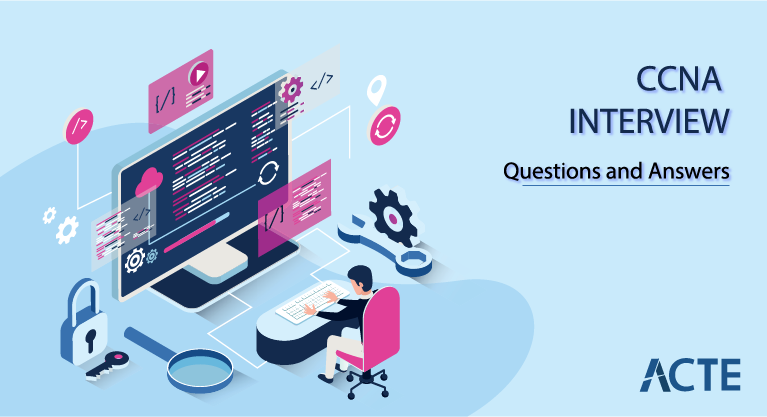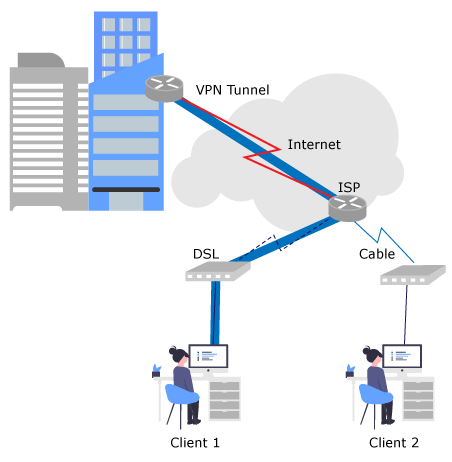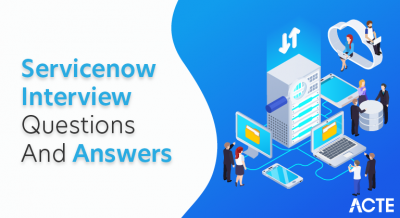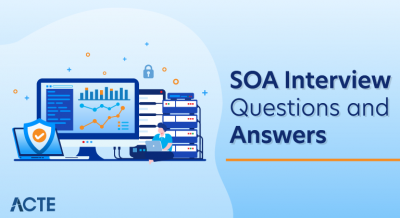
A service desk is a centralized point of contact within an organization for handling IT-related issues and requests from users. It serves as a hub where users can report problems, seek help, and receive support for various IT services, such as software applications, hardware issues, network problems, and more. Service desks aim to ensure prompt resolution of issues, minimize downtime, and enhance user productivity by providing efficient and effective support through well-defined processes and skilled IT professionals.
1. How to diagnose and fix network connectivity issues?
Ans:
To resolve network connectivity issues, first check the user’s device settings and network configurations using tools like `ipconfig` or `ifconfig.` If basic checks fail, restart routers or modems and verify DNS settings. Updating network drivers or resetting the TCP/IP stack usually resolves persistent issues. If problems persist, escalate to network administrators for further investigation.
2. How to troubleshoot email client configuration problems?
Ans:
Check the server configurations and ping the mail server to ensure connectivity when troubleshooting email client problems. Make sure the right login credentials are entered and look for any possible firewall or antivirus program interference. To restore full functionality, Fix the client installation, erase the cached credentials, or recreate email profiles.
3. How to resolve printer connectivity and printing issues?
Ans:
- For printer problems, Start by checking the printer’s status, paper, and toner levels.
- Verify network connectivity by pinging the printer’s IP address and inspecting the settings on the user’s computer.
- Reinstalling printer drivers, updating firmware, or restarting print spooler services typically resolves issues.
- For complex problems, Consult printer manuals or escalate to printer support.
4. How to address slow computer performance?
Ans:
- To improve computer performance, use Task Manager (Windows) or Activity Monitor (macOS) to identify resource-intensive processes.
- Also scan for malware, optimize startup programs, clear temporary files, and update system and driver software.
- Adjusting system settings and performing hardware diagnostics or upgrades also improve performance.
5. How to handle “Blue Screen of Death” (BSOD) errors?
Ans:
When the Blue Screen of Death (BSOD) appears, Record the problem code, see whether the system has changed recently, and restart the computer in Safe Mode to continue debugging. Usually, applying new updates, restoring the system, or updating drivers are the steps involved in fixing software-related BSOD problems. It could be necessary to replace defective parts or run diagnostics for hardware problems.
6. How to troubleshoot software installation failures?
Ans:
For software installation issues, Review installation logs for error codes, verify compatibility, and temporarily turn off security software. Using installation repair tools, clean installation methods, or seeking guidance from software vendors ensures effective troubleshooting. Escalating to specialized support teams resolves complex issues promptly.
7. How to resolve login/authentication issues?
Ans:
- When users face login/authentication problems, verify the username, password correctness, and account status.
- Also check domain connectivity, firewall settings, and group policies to ensure smooth authentication.
- Resetting passwords, unlocking accounts, or updating group policies typically resolves issues; escalation to system administrators addresses domain-level challenges.
8. How to assist with VPN connectivity issues?
Ans:
- To assist with VPN connectivity problems, confirm VPN client settings and internet connectivity, check logs for error codes, and ensure firewall exceptions.
- Reconnecting VPN sessions, updating client software, or reviewing server configurations restores connectivity.
- Collaboration with network administrators resolves persistent VPN infrastructure issues.

9. How to troubleshoot VoIP phone or telephony system problems?
Ans:
For VoIP phone or telephony issues, inspect physical connections, IP settings, and VLAN configurations for voice traffic. Reviewing call logs, checking DHCP settings, and conducting network tests to diagnose issues. Restarting phones, updating firmware, or adjusting SIP settings resolves most problems, ensuring reliable voice communications.
10. What is the difference between RAM and ROM?
Ans:
| Feature | RAM (Random Access Memory) | ROM (Read-Only Memory) |
|---|---|---|
| Purpose | Temporary storage for data and instructions | Stores firmware and permanent system data |
| Volatility | Volatile (loses data when power is turned off) | Non-volatile (retains data when power is turned off) |
| Read/Write Access | Read and write access | Read-only access |
| Function | Stores data actively used by the CPU | Contains initial instructions to boot the computer and basic operating system routines |
11. How to recover data or files for users?
Ans:
When users lose data, determine the cause and search recycle bins/trash or use recovery software to retrieve files. Restoring from backups or employing specialized recovery tools recovers lost data. Educating users on data backup practices prevents future incidents, maintaining data security and integrity. These revised answers outline practical strategies and actions for addressing various technical challenges encountered in a service desk support role.
12. What is an IP address and why is it important?
Ans:
- An IP address (Internet Protocol address) is a unique identifier assigned to each device on a network.
- It enables devices to communicate with each other and facilitates data transfer over the internet or local networks.
- IP addresses are crucial for routing data packets to their destinations and identifying devices within a network.
13. How to troubleshoot a computer that won’t turn on?
Ans:
First, Check the power cable and ensure the power outlet is functional. Verify the computer’s power switch and inspect the power supply unit for issues like blown fuses or loose connections. Testing with an alternate cable or outlet helps isolate external factors. If necessary, consider replacing the power supply unit or seeking hardware support.
14. What is Active Directory?
Ans:
Active Directory (AD) is a Microsoft directory service for Windows networks. It stores information about network objects like computers, users, and groups, providing centralized authentication and access control. AD enables administrators to manage network resources efficiently, enforce security policies, and deploy software across the network.
15. What is the process of setting up a new user in a Windows environment?
Ans:
- In Windows, setting up a new user involves accessing the Active Directory Users and Computers console.
- Create a user account by specifying details such as username, password, and group memberships.
- Settings like password policies and account expiration are configured as needed.
- Access permissions and logon restrictions are set based on the user’s role and requirements.
16. How to handle a computer virus?
Ans:
- When dealing with a computer virus, Immediately disconnect the infected system from the network to prevent further spread.
- Run a comprehensive antivirus scan to detect and remove the virus.
- If the virus persists, utilize specialized removal tools or seek advice from cybersecurity professionals.
- After cleanup, educate users on safe computing practices and apply security updates to prevent future infections.
17. What is a VPN (Virtual Private Network) and what is it used for?
Ans:
A VPN extends a private network across a public network, like the Internet, enabling secure data transmission as if connected directly to the private network. It encrypts data to ensure confidentiality, making it ideal for remote workers accessing corporate resources securely. VPNs also bypass geographical restrictions and enhance online anonymity.
18. What is DNS (Domain Name System) and how does it work?
Ans:
DNS translates domain names (e.g., www.example.com) into IP addresses (e.g., 192.0.2.1) used by computers to locate each other on a network. It functions as a directory service, mapping human-readable domain names to machine-readable IP addresses. DNS operates through a distributed system of servers that store domain records. When a user enters a domain name, DNS resolves it to the corresponding IP address, facilitating internet communication.
19. What is the OSI (Open Systems Interconnection) model?
Ans:
- The OSI model is a conceptual framework defining the functions of a telecommunication or computing system.
- It divides network communication into seven layers, each responsible for specific tasks such as data encapsulation, error detection, and protocol management.
- These layers interact to facilitate communication between devices in a structured manner.
20. How to reset a password in a Windows environment?
Ans:
- To reset a password for a Windows user, access the Active Directory Users and Computers console or the Local Users and Groups management tool.
- After locating the user account, select “Reset Password,” enter it, and confirm a new password.
- Securely communicate the new credentials to the user and verify successful login access.
21. What is the difference between TCP and UDP?
Ans:
TCP (Transmission Control Protocol) and UDP (User Datagram Protocol) are fundamental network protocols used for transmitting data. TCP ensures reliable, ordered delivery of data by establishing a connection between sender and receiver, acknowledging receipt, and retransmitting lost packets. In contrast, UDP is connectionless and does not guarantee delivery order or reliability. UDP is favored for applications prioritizing speed, such as real-time multimedia or gaming.
22. How to troubleshoot a slow internet connection?
Ans:
To address a slow internet connection, begin by testing speed using online tools. If speeds are slow, restart the modem and router, ensuring they’re away from interference sources. Checking Ethernet cables for damage and testing with alternate devices, as adjusting router settings like channel selection or bandwidth allocation, often resolves issues. Contacting the internet service provider might be necessary if problems persist.
23. What are the steps to configure an email account in Outlook?
Ans:
- Setting up an email account in Outlook involves accessing Account Settings, selecting “Add Account,” and entering the email address and password.
- Outlook auto-configures settings for popular providers like Gmail or Office 365, or manually input server details for custom domains.
- After verifying settings and completing setup, Outlook synchronizes emails, contacts, and calendars for seamless access.
24. How to handle data backup and restoration?
Ans:
- Data backup involves creating duplicates of critical files or system images to prevent loss from hardware failures, cyber threats, or accidental deletion.
- Schedule regular backups using backup software or cloud services, ensuring redundancy across multiple storage locations.
- For restoration, accessing backup archives, selecting files or systems, and verifying data integrity post-restoration ensures successful recovery and continuity.
25. What is a BSOD (Blue Screen of Death) and how can it be resolved?
Ans:
BSOD occurs due to critical errors in Windows, leading to system shutdown to prevent data loss. To resolve it, note the error code, start in Safe Mode, uninstall recent problematic software or updates, update device drivers, run system diagnostics, or restore to a stable system configuration. Hardware issues may require professional assistance or component replacements.
26. What is the process of network troubleshooting?
Ans:
Network troubleshooting begins by identifying symptoms like slow speeds or connectivity issues. Checking physical connections, using tools like `ping` or `tracert` to test connectivity, reviewing router logs, updating firmware, or adjusting network settings helps optimize performance. Collaboration with network administrators or contacting ISPs resolves complex issues affecting network stability.
27. How to map a network drive?
Ans:
- Mapping a network drive assigns a drive letter (e.g., Z:) to a shared folder or network location for quick access.
- In Windows, navigating to File Explorer, selecting “This PC,” and choosing “Map network drive,” specifying the folder path (e.g., \\server\share), and entering credentials grants access for seamless file sharing and collaboration.
28. What is the purpose of a firewall?
Ans:
- A firewall acts as a security barrier between internal and external networks, regulating incoming and outgoing traffic based on predefined rules.
- It prevents unauthorized access, blocks malicious activities like malware or hacking attempts, and ensures network integrity by enforcing access controls and filtering potentially harmful data packets.
29. How to deal with a printer that is not working?
Ans:
Troubleshooting a non-functional printer involves checking power and connectivity and addressing issues like paper jams, low ink or toner levels, or error messages on the printer’s control panel. Updating printer drivers, restarting print spooler services, performing printer diagnostics, consulting printer manuals, or seeking technical support to resolve software or hardware issues effectively.
30. What is the importance of cybersecurity in a service desk role?
Ans:
Cybersecurity is essential in a service desk role to protect organizational data, systems, and user privacy from cyber threats. Educating users on safe practices, enforcing security policies, and responding promptly to incidents like malware attempts enhances network resilience. Implementing strong authentication, updating software patches regularly, and conducting security audits mitigate risks, ensuring a secure computing environment for all users.
31. How can a user handle being unable to log into their computer?
Ans:
- If a user encounters login issues, start by verifying their credentials and ensuring they are correct.
- Next, check for network connectivity problems and reboot the computer if necessary.
- If local login fails, attempt to log in with administrative privileges to diagnose profile or permission issues.
- If needed, reset the user’s password or escalate the problem to higher-level support for further investigation, aiming to minimize disruption to user productivity.
32. How can screen flickering reported by a user be resolved?
Ans:
- To address screen flickering, initial steps include updating graphics drivers and adjusting display settings like refresh rate and resolution.
- Also investigate potential software conflicts, turn off unnecessary background applications, and run antivirus scans to identify and resolve underlying causes.
- If issues persist, consider hardware diagnostics or consult manufacturer support for specialized troubleshooting.
33. How can multiple support tickets be managed simultaneously?
Ans:
Efficiently managing multiple support tickets involves prioritizing based on urgency and impact on business operations. Utilize a ticketing system to categorize and track tickets, ensuring each receives appropriate attention. Multi-tasking and effective time management help me allocate resources efficiently, maintain transparent communication with users regarding expected resolutions, and escalate critical issues promptly to uphold service.
34. How has someone gone above and beyond for a customer?
Ans:
Encountered a persistent email configuration issue for a customer. Proactively researched and implemented an update to the email client, improving compatibility and performance, provided personalized guidance to the customer on the update’s benefits, ensuring a seamless transition and resolving longstanding issues. This initiative not only addressed the problem effectively but also strengthened customer trust and satisfaction.
35. How can tasks be prioritized when dealing with multiple urgent issues?
Ans:
- When facing multiple urgent issues, prioritize tasks based on severity and impact on business operations.
- Evaluate each issue’s criticality, considering its implications for productivity and system stability.
- Using a prioritization matrix or urgency scale, categorize tasks and communicate priorities clearly to stakeholders.
- Regular updates on progress and adjustments to task management ensure the effective resolution of critical issues within required timelines.
36. How can a difficult or angry customer be handled?
Ans:
- When dealing with a challenging customer, maintain a calm and empathetic approach, actively listening to understand their concerns.
- Acknowledge their frustrations and assure them for commitment to finding a resolution.
- Focus on solutions rather than escalating emotions, maintaining professionalism throughout the interaction.
- If necessary, Involve a supervisor or colleague to provide additional support or alternative perspectives, ensuring a positive outcome and preserving customer satisfaction.
37. How can a user complaint about a slow computer be addressed?
Ans:
When addressing a user’s complaint about slow computer performance, initial steps involve checking system performance metrics such as CPU and memory usage through Task Manager. Scan for malware or unnecessary startup programs that may affect performance. Updating software and drivers, optimizing disk space usage, and defragmenting the hard drive are essential steps to improve system responsiveness.
38. How can a situation be handled when the answer is unknown?
Ans:
If faced with an unfamiliar problem, Acknowledge the user’s concern and assure them of commitment to investigating and resolving the issue. Utilize available resources such as knowledge bases and documentation or seek guidance from colleagues with relevant expertise to research the problem thoroughly. Transparent communication with the user regarding troubleshooting steps and estimated timelines builds trust and ensures their involvement.
39. How can a technical concept be explained to a non-technical person?
Ans:
- Frequently encounter opportunities to explain technical concepts to non-technical individuals.
- In a recent instance, Simplified the explanation of cloud computing to emphasize its benefits like scalability and cost-efficiency.
- Used analogies and visual aids to illustrate complex ideas, ensuring clear understanding and engagement.
- Adapting communication style to match the audience’s knowledge level and addressing questions comprehensively enhanced their confidence in adopting new technologies effectively.
40. How can a request that is beyond the scope of work be handled?
Ans:
- When presented with a request outside scope of responsibility, respectfully clarify the role and offer alternative solutions within expertise.
- If appropriate, redirect the request to the relevant department or escalate it to specialized teams or management for further handling.
- Upholding professional boundaries while demonstrating willingness to assist within reasonable limits ensures efficient resource allocation and adherence to organizational protocols.
41. How can a mistake made at work be handled?
Ans:
Experienced an oversight with a critical update that temporarily disrupted system operations. Upon discovering the issue, promptly notified team and initiated a rollback to restore functionality. Taking accountability, apologized to affected users and implemented measures to prevent recurrence, such as enhancing update validation processes and conducting thorough testing before deployment.
42. How can problem-solving be approached within a team setting?
Ans:
During a network outage, Collaborated with team members to swiftly identify the root cause. Divided tasks based on expertise, maintained open communication channels, and shared findings in real time. By coordinating effectively and leveraging each other’s strengths, we resolved the issue promptly, minimizing downtime and showcasing our collective problem-solving skills.
43. How can excellent customer service be ensured?
Ans:
- Ensure exceptional customer service by actively listening to understand needs, maintaining an upbeat demeanor, and responding promptly to inquiries or issues.
- Tailor interactions to address specific concerns, follow up to ensure satisfaction, and actively seek feedback for continuous improvement.
- By prioritizing empathy, clear communication, and proactive support, I consistently strive to exceed customer expectations.
44. How can high-pressure situations be managed?
Ans:
- During a critical system failure, remained composed, prioritized tasks based on impact, and kept stakeholders informed about progress and expected timelines.
- Delegating tasks where feasible, focused on troubleshooting efficiently and escalated issues promptly when necessary.
- By managing stress effectively and maintaining focus on solutions, successfully restored services within the expected downtime.
45. What strategies do user use for effective time management?
Ans:
To manage time effectively, prioritize tasks based on urgency and importance using tools like to-do lists or task management software. Allocate dedicated time blocks for specific activities, minimize distractions, and set realistic goals to maintain productivity. Regular reviews of progress help me adjust priorities as needed, ensuring deadlines are met while upholding quality standards in work.
46. How can a challenging IT issue be resolved?
Ans:
Successfully resolved a complex database corruption issue by conducting a thorough analysis, collaborating closely with database administrators, and executing meticulous data recovery procedures. Throughout the process, documented each step rigorously, explored alternative solutions, and maintained transparent communication with stakeholders. Through perseverance and technical expertise, restored data integrity, ensuring minimal disruption.
47. How can constructive criticism from a colleague or supervisor be handled?
Ans:
- Embrace constructive criticism as an opportunity for personal and professional growth.
- Actively listen to feedback, reflect on suggestions with an open mind, and seek clarification to grasp areas needing improvement entirely.
- Taking ownership of mistakes, prioritize actionable steps for development and value feedback as a catalyst for achieving higher performance standards and continuous improvement.
48. How can learning something new quickly be approached?
Ans:
- When tasked with configuring a new software tool, immersed in learning through extensive research, vendor documentation, and hands-on practice.
- Seeking guidance from knowledgeable colleagues, applied acquired knowledge immediately to practical tasks.
- By adopting a proactive learning approach and leveraging available resources effectively, quickly gained proficiency and successfully implemented the new tool within project timelines.
49. What steps can be taken to maintain confidentiality and data security?
Ans:
Uphold confidentiality and data security by strictly adhering to established policies and protocols. Handle sensitive information discreetly, encrypt data as needed, and utilize secure communication channels. Remaining vigilant about cybersecurity threats, actively participate in training to stay updated on best practices and comply with data protection regulations to safeguard organizational and client data.
50. How to handle a disagreement with a team member?
Ans:
Initiating a respectful dialogue, actively listened to their viewpoint and sought common ground to align objectives. Through collaboration and compromise, identified a hybrid approach that effectively integrated both perspectives. This experience underscored the importance of teamwork, mutual respect, and achieving shared project goals through constructive communication.
51. How to approach troubleshooting an unfamiliar issue?
Ans:
- When encountering an unfamiliar issue, begin by gathering comprehensive information through research and documentation and seeking insights from colleagues.
- Breaking down the problem into smaller components helps isolate potential causes systematically.
- I employ diagnostic tools and test hypotheses to identify the root cause effectively.
- Regular updates and collaboration with team members provide fresh perspectives and contribute to finding optimal solutions.
52. How to identify a potential problem before it escalates?
Ans:
- Through proactive monitoring and analysis of performance metrics, identified an emerging memory leak issue early on.
- Promptly notifying the team, Implemented interim measures to minimize impact and collaborated with developers to deploy a permanent solution.
- This proactive approach averted service disruptions and underscored the importance of preemptive monitoring for system stability.
53. How to document and track resolved issues?
Ans:
Document and track resolved issues using a structured approach. After resolving an issue, update detailed notes in a centralized ticketing system or knowledge base. This includes a thorough description of the problem, steps taken for resolution, and any relevant findings. Categorizing issues by type and severity facilitates future reference and analysis.
54. How can a process be improved in a previous job?
Ans:
Recognizing inefficiencies in software update deployments, proposed implementing automated deployment scripts in a previous role. Collaborating closely with the development team, designed and tested these scripts to streamline operations and reduce manual errors significantly. This initiative not only enhanced efficiency but also optimized team productivity and minimized downtime during software updates.
55. How to determine the root cause of a recurring issue?
Ans:
- When addressing recurring issues, start by reviewing past incident reports and identifying recurring patterns or triggers.
- Thorough investigations involve analyzing system logs, conducting diagnostic tests, and assessing recent changes or updates.
- Root cause analysis techniques such as the “5 Whys” method or fishbone diagrams help trace symptoms back to underlying causes systematically.
56. How can support be provided for a software application that hasn’t been used before?
Ans:
- Tasked with supporting an unfamiliar software application, begin by studying its available documentation, vendor resources, and online tutorials to grasp its functionalities and common issues.
- Setting up a test environment allows me to explore the software’s features and simulate user scenarios.
- Engaging with vendor support or seeking guidance from experienced colleagues helps build practical knowledge and troubleshooting skills.
- Through proactive learning and hands-on experience, ensure adequate support and problem resolution for users.
57. How can different types of issues and their solutions be tracked?
Ans:
To track diverse issues and their solutions, maintain a detailed log in a centralized repository or knowledge base. Problems are categorized based on type, severity, and affected systems or applications. Each entry includes a comprehensive description of the problem, troubleshooting steps, and the final resolution. Regular updates and reviews of documented solutions ensure accuracy, accessibility, and relevance.
58. How can multi-tasking be used to get things done?
Ans:
In a dynamic work environment, effective multi-tasking involves prioritizing tasks based on urgency and criticality. Use task management tools and prioritization techniques to organize activities and allocate time efficiently. Transparent communication with stakeholders and regular progress updates help manage expectations and ensure timely task completion.
59. How can the effectiveness of solutions be evaluated?
Ans:
After implementing solutions, Evaluate their effectiveness by monitoring system performance metrics, gathering user feedback, and comparing results against predefined benchmarks or service level agreements (SLAs). Continuous observation and adjustments based on ongoing assessments ensure optimal performance. Collaborating with stakeholders to validate outcomes and solicit feedback supports the refinement of solutions.
60. How can the approach to solving a problem be changed?
Ans:
- In addressing a challenging issue, initially applied conventional troubleshooting methods without success.
- Recognizing the need for a different approach, consulted subject matter experts, conducted additional research, and explored alternative methodologies.
- This proactive approach led to the identification of a previously overlooked root cause and the implementation of an effective solution.
- Embracing flexibility and ongoing learning in problem-solving underscored the value of adapting strategies to achieve successful outcomes.
61. How to ensure a customer feels heard and understood?
Ans:
- Ensure customers feel heard and understood by actively listening to their concerns without interruption.
- Acknowledging their perspective and clarifying any uncertainties demonstrates empathy and attentiveness.
- Summarizing their issue and proposing solutions reassures them that their concerns are being effectively addressed.
62. How to deliver bad news to a customer?
Ans:
Transparency and empathy are top priorities when breaking bad news. Offer a concise explanation of the circumstances, highlighting the pertinent details and sincerely apologizing for any inconvenience this may have caused. To lessen the damage and make sure the client feels valued and supported at every stage, Also provide alternate alternatives or next steps.
63. How to handle dissatisfied customers?
Ans:
Addressing dissatisfaction involves attentively listening to understand their specific concerns and validating their feelings. Remaining calm and courteous, empathize with their experience and apologize sincerely for any inconvenience. Collaborate to find a resolution that meets their expectations, providing regular updates and ensuring transparency throughout.
64. How to communicate complex information to non-tech-savvy customers?
Ans:
- When explaining complex information to non-tech-savvy customers, use straightforward language and avoid technical jargon.
- Break down concepts into simpler terms, using analogies or visual aids when necessary to ensure they feel comfortable and informed without feeling overwhelmed.
- Patiently answering questions helps them grasp technical details effectively.
65. How to receive positive feedback from a customer?
Ans:
- Received positive feedback when a customer expressed appreciation for assistance in promptly resolving their issue.
- They highlighted professionalism and patience in guiding them through troubleshooting.
- Such feedback motivates me to uphold high standards of customer service and underscores the value of attentive support.
66. How to balance quality support with performance metrics?
Ans:
Prioritize delivering quality support by understanding customer needs and resolving issues effectively. Concurrently, monitor performance metrics to ensure timely responses and adherence to service-level agreements. Regular self-assessment and efficiency improvements help maintain high standards of support while meeting performance targets.
67. How to address recurring issues for a customer?
Ans:
When a customer faces recurring issues, conduct a thorough investigation to identify underlying causes. Documenting previous interactions and solutions ensures continuity in troubleshooting efforts. Collaborating with colleagues and escalating when necessary, strive for a permanent resolution. Regular updates and proactive communication reassure the customer of ongoing support and resolution efforts.
68. How to follow up with customers after issue resolution?
Ans:
- After resolving an issue, follow up with customers to ensure their satisfaction and confirm the problem has been fully addressed.
- Appreciating their feedback on the resolution process and welcoming further questions or concerns demonstrates ongoing support.
- Documenting follow-up discussions in the customer record ensures continuity and reinforces dedication to their satisfaction.
69. How to manage a customer’s expectations?
Ans:
- Manage expectations by setting realistic timelines and clearly communicating potential outcomes.
- If challenges arise, provide prompt updates and explain any delays or changes in plans.
- Managing expectations with transparency fosters trust and demonstrates a commitment to delivering reliable service.
70. How to build rapport over the phone or email?
Ans:
To build rapport, convey warmth and professionalism through clear and respectful communication. Actively listening to understand their needs and responding promptly with helpful information or solutions helps establish a connection. Personalizing interactions and maintaining a positive attitude, whether over the phone or through email, fosters a supportive and trust-based relationship.
71. What level of proficiency is there in software and tools?
Ans:
Skilled in using a variety of essential software and tools for IT support. These include Microsoft Office Suite for documentation and communication, ServiceNow and Zendesk for efficient ticket management, and remote support tools like TeamViewer and AnyDesk. Additionally, utilize diagnostic tools such as PingPlotter and Wireshark to troubleshoot network issues effectively across different platforms and environments.
72. What experience is there with remote desktop support?
Ans:
- Career, have gained extensive experience in remote desktop support using tools like Remote Desktop Protocol (RDP), TeamViewer, and VNC.
- These tools enables to securely connect to users’ systems, troubleshoot issues, install software, configure settings, and provide real-time assistance.
- This approach ensures minimal disruption and effective problem resolution for remote users.
73. What is the organizational approach to handling support tickets?
Ans:
- To manage a high volume of support tickets efficiently, prioritize tasks based on urgency and impact on operations.
- Utilize robust ticketing systems such as ServiceNow and Zendesk to categorize, track, and manage tickets effectively.
- Regular updates on ticket statuses, setting realistic timelines for resolutions, and proactive communication with users and stakeholders help maintain organization and ensure timely responses.
74. What experience is there with ITIL processes?
Ans:
Extensive experience implementing ITIL processes such as incident management, problem management, change management, and service request fulfillment. Adhering to ITIL best practices has helped streamline service delivery, improve service quality, and align IT services with business objectives. This structured approach enables me to prioritize tasks effectively, minimize service disruptions, and enhance overall service efficiency.
75. What experience is there with mobile device support?
Ans:
Possess comprehensive experience in supporting mobile devices across various platforms, including iOS and Android. This includes configuring email accounts, troubleshooting connectivity issues, performing updates, and resolving application-related issues. Utilizing mobile device management (MDM) solutions like AirWatch and MobileIron ensures compliance with security policies and seamless support for mobile users.
76. What experience is there with monitoring tools in previous roles?
Ans:
- Effectively utilized monitoring tools such as Nagios, SolarWinds, and Zabbix to monitor network performance, server health, and application availability.
- These tools enable proactive monitoring, alerting for potential issues, performance optimization, analyzing tracking data and generating reports to help identify trends, preempt issues, and optimize system performance.
77. What experience is there with network configuration and troubleshooting?
Ans:
- Have hands-on experience in network configuration and troubleshooting, including setting up routers, switches, and firewalls.
- Skills include configuring VLANs, implementing subnetting, and resolving connectivity issues using tools like Cisco Packet Tracer and PuTTY.
- Troubleshooting TCP/IP issues, DNS resolution problems, and conducting network diagnostics are integral parts of network support experience.
78. What familiarity is there with helpdesk ticketing systems?
Ans:
Proficient in using helpdesk ticketing systems such as ServiceNow, Zendesk, and JIRA Service Desk. These platforms facilitate logging, prioritizing, and managing support tickets effectively. Assign tickets to appropriate teams, track statuses, update ticket notes, and ensure timely resolution of user issues. Leveraging these systems enhances communication, promotes collaboration, and improves overall service delivery.
79. What contributions have been made to knowledge bases or documentation?
Ans:
Actively contributed to knowledge bases and documentation repositories. Document troubleshooting procedures, best practices, and solutions for recurring issues. Updating knowledge articles in platforms like Confluence and SharePoint ensures accessible and up-to-date information for team members and end-users. This proactive approach fosters knowledge sharing and enhances support efficiency.
80. What experience is there with scripting or automation?
Ans:
- Practical experience using scripting languages such as PowerShell and Bash to automate routine tasks and streamline system administration.
- Scripting processes for software deployment, user provisioning, and system monitoring have significantly reduced manual effort, minimized errors, and improved operational efficiency.
- Continuously enhance scripting skills to optimize workflows and deliver efficient IT services.
81. What motivates to work for the company?
Ans:
Particularly interested in company due to its strong reputation for innovation and customer satisfaction. Commitment to [specific aspect of the company’s mission or values] resonates with professional goals and principles. Enthusiastic about contributing skills and experience to team and playing a role in advancing [specific aspect of the company’s objectives or initiatives].
82. What are the key responsibilities of a service desk technician?
Ans:
- Providing timely technical support to users.
- Resolving hardware and software issues.
- Documenting incidents and solutions.
- Maintaining IT systems and infrastructure.
- Ensuring exceptional customer service.
83. How to handle a fast-paced environment?
Ans:
Excel in fast-paced environments by strategically prioritizing tasks based on urgency and impact, maintaining transparent communication with stakeholders, and staying meticulously organized. Effectively managing priorities allows me to navigate workload demands while ensuring critical issues receive prompt attention. Adaptability and maintaining composure under pressure are crucial for sustaining productivity and delivering quality service.
84. How to deal with a high volume of support requests?
Ans:
When confronted with a high volume of support requests, prioritize tasks based on their urgency and impact. Efficient utilization of ticket management systems helps categorize and monitor issues effectively. Clear and proactive communication with users regarding expected response times and progress updates fosters transparency and manages expectations.
85. What is considered the most crucial quality for a service desk technician?
Ans:
- Empathy is the cornerstone quality for a service desk technician.
- Empathizing with users’ frustrations when encountering technical challenges builds trust and rapport.
- It enables me to deliver personalized support tailored to their needs, enhancing overall satisfaction and fostering positive relationships.
86. How to handle confidential information?
Ans:
- Handle confidential information with the utmost discretion and adherence to company policies and regulatory requirements.
- This involves securing sensitive data both physically and digitally, limiting access to authorized personnel only, and ensuring proper disposal when necessary.
- Upholding strict confidentiality safeguards protects sensitive information and maintains trust with stakeholders.
87. How can meeting a tight deadline be ensured?
Ans:
Faced a stringent deadline while [describe specific project or task]. To meet this deadline, meticulously planned and organized tasks, prioritized critical actions, and maintained open communication with stakeholders regarding progress and potential challenges. Remained focused, adaptable, and proactive in leveraging resources and seeking necessary support to ensure successful completion within the allocated timeframe.
88. How can compliance with company policies and procedures be maintained?
Ans:
To uphold compliance with company policies and procedures, regularly review and acquaint with relevant guidelines and regulations. Integrating compliance requirements into daily operations and decision-making processes ensures adherence. When uncertainties arise, seek guidance from supervisors or compliance officers and actively participate in training sessions to remain informed about policy updates and procedural changes.
89. How can contributions to improving service desk operations be made?
Ans:
- Eager to contribute to enhancing service desk operations by applying expertise in [specific area of proficiency, e.g., incident management, process optimization].
- This involves analyzing current workflows, identifying areas for enhancement, and proposing pragmatic solutions.
- Implementing best practices, refining training initiatives, and fostering a collaborative team environment are strategies employ to bolster efficiency and elevate customer satisfaction.
90. What are the expectations from the manager in terms of support and feedback?
Ans:
Value clear and constructive communication, regular feedback, and opportunities for professional development from manager. Guided support in navigating challenges, access to resources for skill enhancement, and acknowledgment of accomplishments are instrumental in professional growth. Routine check-ins to discuss performance objectives and career aspirations help align with efforts and team objectives, ensuring contribute effectively.






